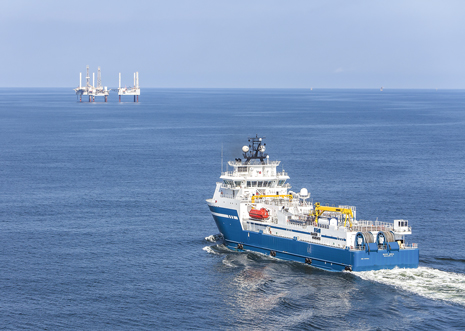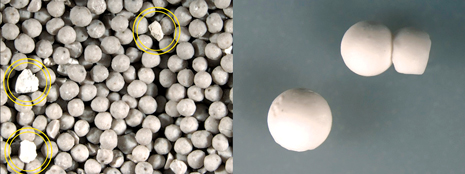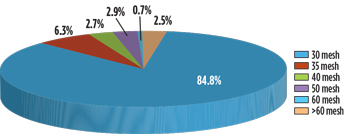 |
| A stimulation vessel in the Gulf of Mexico. |
|
A new, proppant-sized solid-scale inhibitor—with a substrate based on nanotechnology—was recently applied in a deepwater Gulf of Mexico (GOM) frac-pack completion, to inhibit barium sulfate scale deposition for a high volume of cumulative water production. The inhibitor was used in a well, where the field design called for a sulfate-rich seawater flood to mix with a barium-rich connate water. The subsea oil well, in 1,700 ft of water, was frac-packed with 14,881 lb of proppant, of which 1,488 lb—or 10%—were the new, solid-scale inhibitor.
Baker Hughes’ Sorb Ultra solid inhibitor uses a patented, spherically-shaped, high-strength nano material that is the same size as a proppant, and provides high internal and external surface areas, onto which a robust scale inhibitor is adsorbed. The end result is proppant-sized material that combines strength, greater than that of an intermediate-strength proppant, with a high amount of an active scale inhibitor, to provide primary stimulation and prolonged flow assurance with significantly reduced intervention operations.
SCALE AND INHIBITORS
Typically, deepwater wells are gravel- or frac-packed. This is done to provide a secondary barrier to fines migration; the primary barrier being the screen. In addition to formation fines migrating to the gravel- or frac-pack, this is also the area—known as the near wellbore—where inorganic scale deposition creates the biggest operational problem. The deposition of scale occurs when oilfield operations disturb the formation equilibrium that has existed for millions of years. Even a slight change in temperature or pressure may affect the pH and cause the process, of scale formation and deposition, to be set into motion. Mixing of non-native waters or salts can also upset the balance of dissolved salts. How quickly scale deposits form depends on the rate of nucleation combined with the rate of crystal growth. Many waters do not immediately form scale deposits upon the start of production, and some waters never form scale at all. However, scale formation often begins, almost immediately, when conditions in the formation begin to change.
Scale inhibitors interrupt crystal growth or slow the nucleation process that impacts the rapidity of scale formations. As the inhibitor is pumped back into the wellbore, the crystal growth, or nucleation, is slowed to a level that keeps inorganic scale deposits to a minimum. Conversely, if scale formation and deposition are not inhibited, the scale can quickly reduce production and lead to repeated remediation operations. In severe cases, particularly offshore, expensive workovers are required to remove deposits and repair corrosion-damaged assets. In a deepwater, subsea well, the cost of an intervention can exceed $10 million. The goal of chemical scale inhibitors is to retard scale formation and deposition, at least until the produced water has reached the surface facilities.
Traditionally, inhibitors have been applied to a well in one of three ways: continuous or batch injection of a liquid stream down the annulus, or through a capillary tubing string, which requires frequent visits to the well, to maintain chemical tanks or re-inject chemicals; a slow effusing liquid inhibitor placed in the rat hole, which requires frequent replenishment of the chemical; and a squeeze treatment that injects a liquid inhibitor into the near-wellbore area, where it mixes with producing fluids. The first two options protect only the tubulars in the wellbore. The third option, the squeeze treatment, protects the wellbore, perforations and near-wellbore formation. Typically, a squeeze must be repeated every six to 12 months.
DEEPWATER SOLUTION
All of the traditional chemical inhibitor applications have limitations in deep water. Continuous, batch and rathole treatments have delivery issues, and offer no protection in the formation or perforations. Squeeze treatment has been the conventional choice; however, it requires large volumes of chemicals, offers no predictability as to where the treatment actually ends up in the formation, and has a relatively short treatment life.
In 2005, Baker Hughes introduced Sorb solid inhibitor technology, by which chemical inhibitors are adsorbed onto a proppant-like substrate; fed with the proppant during the hydraulic fracturing operation; and pumped deep, and evenly, into the formation. Upon production of hydrocarbons, or water, the solid-state, slow-releasing inhibitor is released into the fluid stream, to inhibit the deposition of scale and other contaminants, such as paraffin and asphaltenes. Since 2005, more than 20,000 wells have been fractured using this technology.
However, while the Sorb inhibitor has performed exceptionally in land wells, it has limited use in the gravel- and frac-pack market. This is due, primarily, to the limitation on the mass of Sorb that can be used, because of issues related to conductivity. By limiting the amount used, a limitation is also placed on the total amount of chemical available to provide a long treatment life. Sorb Ultra uses a stronger substrate, and thus a high weight percent (wt%) can be used. This results in the placement of a greater total amount of chemical in the formation.
The ideal inhibitor for a deepwater well meets three critical criteria. First, it does no harm to the formation. Second, it is compatible with a wide range of stimulation fluids. And third, it retards, or prevents, scale sufficiently to preclude the need for an intervention, for a time period well in excess of the expectation from any other form of prevention.
The Sorb Ultra product used in this application consists of the high-strength solid carrier with a non-phosphonate scale inhibitor that can be monitored by laboratory or field analysis techniques. These inhibitors are effective for barium- and strontium-sulfate scale formation, as well as for calcium carbonate and calcium sulfate formation. The product is added with conventional intermediate- or high-strength proppant at any ratio up to 100% Sorb Ultra. This results in the inhibitor being placed along the entire volume of the proppant pack. Because the inhibitor is retained in the proppant pack, without plugging the pore throats, it can be used in a wide range of reservoir conditions. The release profile is designed to provide immediate availability—as well as sustained, long-term availability of the inhibitor.
In laboratory and field tests, the new material demonstrated no conductivity loss, when added at up to 20 wt% to high-strength (bauxite) proppant. I also can withstand up to 16,000-psi closure stress. Continuous monitoring of the scale-inhibitor residual, in the produced water, shows a concentration above the minimum inhibitor concentration (MIC)—typically around 1–3 ppm for calcium carbonate and 5–10 ppm for barium sulfate—for up to five years for low water producers, and for over 1 MMbbl of cumulative water in a high water-producing well. The application can be applied to any type of formation and any completion technique, wherever a proppant is used. The ScaleSorb Ultra used in the current case history is totally inert; it will not dissolve over time, so there is no risk of fines migration.
The scale inhibitor desorbs only into the water phase of production, so a treated well—which produces only oil during the early stages of production—can still benefit from a complete arsenal of scale inhibitors when water production eventually begins.
A final advantage of the new inhibitor technology for deep water is shape, Fig. 1. The original, chemical-laden substrate is irregular in shape, which is not a concern in fractures; it is, however, a concern in gravel- and frac-packs. The new, higher-strength material is spherical, which tightens the fit to reduce sand migration and makes it better situated as a gravel- or frac-pack additive. For deepwater wells—which are traditionally gravel- or frac-packed—the new material can provide prolonged inhibitor life to delay, or eliminate, future interventions. This represents a significant saving on projected expenditures, as well as an ongoing flow assurance program that protects against scale deposition, from the formation to the surface.
 |
| Fig. 1. A comparison of Sorb particles vs. Sorb Ultra particles. Sorb Ultra uses a patented, spherically-shaped, high-strength nano material. |
|
LABORATORY EVALUATION
To test the new scale-inhibitor composite for release, a length of 35-cm stainless steel pipe, with an internal diameter (ID) of 1.08 cm, was fitted with provisions to attach tubing to each end, such that water, or other fluids, could be injected at one end and exit at the other. The column was filled with 55 g of 20/40 mesh proppant, containing 10 wt% of the 30 mesh composite.
The proppant and composite were intimately mixed, to disperse the composite product throughout the entire proppant column. The pore volume of the test column was 12 ml. A synthetic brine of 0.025 mol/L, CaCl2; 0.015 mol/L, NaHCO3; 1 mol/L, NaCl; sparged with 100% CO2, was pumped through a high-pressure, liquid chromatography (HPLC) pump into the column, at the rate of 2 ml/min. The effluent from the column was collected periodically and analyzed, for the presence of scale inhibitor, by a UV photometer. The inhibitor return concentration, in the first few pore volumes, was above 200 ppm, but it fell rapidly to around 10 ppm, and dropped further, to less than detection limit (5 ppm), after 200 pore volumes of return fluid.
Dynamic tube-blocking tests were carried out to determine the MIC of scale inhibitor with 50% seawater breakthrough. Under the test conditions, a blank scaling time of around 28 min. was observed. It was known already that the high-strength solid inhibitor can provide complete inhibition at a concentration of 15 ppm. A slow buildup of pressure was observed, as the solid inhibitor concentration dropped to 7.5 ppm, indicating that the MIC for this well, under worst-case scenario—that is, 50% seawater breakthrough—would be between 7.5 ppm and 15 ppm.
To test for fluid compatibility, crosslinked fluids were rheologically tested at 200°F, in both the presence and absence of 10-pptg solid-scale inhibitor. The response to the test is evaluated for significant changes in the curve. In the case of this product, when compared to a standard, no changes in gel breaking time were observed. This leads to the conclusion that the solid-scale inhibitor has no compatible issue with current fracturing fluid formulations.
Proppant crush resistance is a standard test to evaluate the suitability of a particular proppant, at a given closure stress. Undue crushing will result in conductivity damage, due to the generation of fines, as well as the loss of fracture width of the proppant pack. To conduct the test, 40 g of the 30-mesh sample are placed in an API crush cell. The piston is added and rotated 180°. The sample is then placed on a press, the specified stress is applied over 1 min., held for 2 min., and then released. The sample is then re-sieved. All material that falls through the smallest sieve is considered fines.
At 10,000 psi, the test results indicated that approximately 15% of the sample was crushed, and a substantially small fraction of the crushed sample can be considered as fines, especially when combined with proppant of 20/40 mesh size. According to API 60, a crush of less than 10% is allowed at a given stress. Therefore, at closure pressures around 10,000 psi, the solid inhibitor does not, significantly, impact the proppant’s integrity, when used at a loading less than 66%, Fig. 2.
 |
| Fig. 2. Particle size distribution percent of crush test results of 30 mesh, high-strength, solid-inhibitor composite. At closure pressures of around 10,000 psi, the solid inhibitor does not significantly impact the proppant’s integrity, when used at a loading of less than 66%. In this job, a more conservative treatment rate of 10% loading weight was applied. |
|
A spectrophotometric procedure was followed, to determine the residual of the high-strength, solid-scale inhibitor in aqueous solutions. The initial residual—both liquid and solid—was noted as a function of cumulative barrels of produced water during the first two days of production.
FIRST GOM APPLICATION
A deepwater GOM operator had plans to complete an oil well as a seawater flood. In reviewing potential flow assurance issues, the operator, who expected barium scale deposition when seaflood water mixed with high-barium-content connate water, wanted to forestall the onset of scale in the formation and perforations. Because seawater is high in sulfate, the mixing of high barium water and seawater, in the reservoir, creates a scenario for harmful scale deposition.
Barium sulfate scale is a non-acid soluble scale. Once formed, it is quite difficult to remove. Unlike carbonate scale, which is soluble in acid, barium scale must be handled in a progressive and expensive manner that includes chelating chemistry, sufficient downhole temperature, and long periods of soaking. Even under optimum conditions, barium scale removal often calls for the use of mechanical means, such as coiled tubing.
A plan was developed to address the issue by proactively treating the well against barium scale. The operator decided to use the ScaleSorb Ultra offering. The inhibitor was mixed with proppant, on the fly, during the frac-pack operation.
The single-zone frac-pack inside a 5½-in., 23 lb/ft liner completion fluid was carried out, using 9.9-ppg CaCl2 in 1,200 ft of water. TVD was 10,861 ft. Bottomhole temperature and pressure were 199˚F and 5,430 psi, respectively. The fracture pressure was 6,892 psi. Total proppant placed in the formation was 13,895 lb of 20/40 mesh, with a bulk density of 117 lb/sq ft. A borate crosslinked frac fluid system, with a 5% KCl base, was the carrier fluid. The frac fluid was pumped, at an average 12 bpm. Average pressure during the frac job was 5,700 psi; maximum pressure at screen-out was 7,791 psi. The net pressure gained during the job was approximately 1,300 psi, and a tip screen-out was achieved. Increases in net pressure generally reflect a wider, more conductive fracture.
The solid-scale inhibitor was pumped at a 10% ratio to the intermediate strength proppant (ISP). The ISP was a 20/40 mesh size; the scale inhibitor solid particle was a 30 mesh size. The solid chemical was pumped throughout at the 10% add rate. At the maximum rate, the proppant was added at 10 ppa, and the solid-scale inhibitor product at 1 ppa. A total of 1,389 lb of solid-scale inhibitor was added.
 |
| Fig. 3. The post-stimulation monitoring assessments aid in optimizing subsequent well treatments, by measuring stimulation effectiveness and inhibitor residuals. |
|
The well was put on production, and it immediately flowed both oil and water. Initial production was 636 bopd and 635 bwpd. BHP was 4,240 psi. All post-frac pack production data indicated the job was a success. After two months, and two fluid sample tests (Fig. 3), the analysis of the residual scale inhibitor in the produced water demonstrated that the scale inhibitor was still present, and was still inhibiting scale in the formation. 
ACKNOWLEDGEMENTS
This article was adapted from SPE paper 168615.
|






